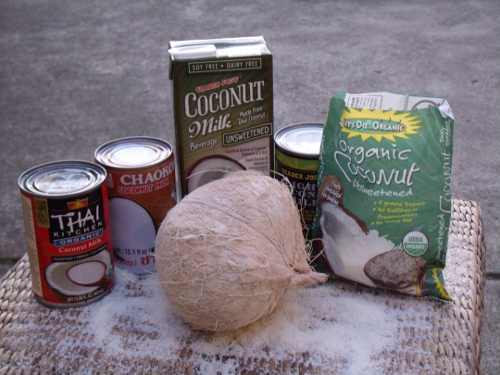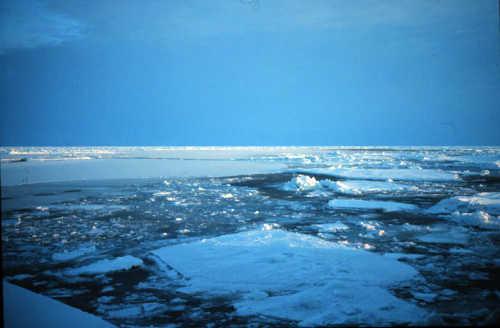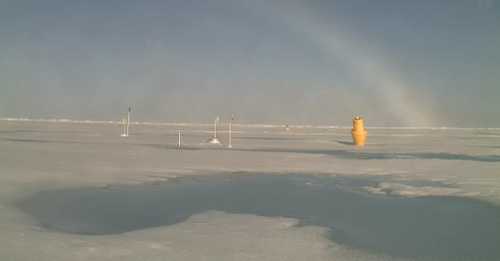
Shown here are are canned coconut milk for cooking (including organic and light versions), coconut milk in aseptic packaging as a substitute for soy or dairy milk, organic coconut flakes and a white coconut. Photo by Esther Oertel.
One of my favorite childhood memories is of my family huddled on our front porch around a bristly brown coconut with screwdriver and hammer in hand.
After some discussion, the hammer was wielded on the poised screwdriver so that holes were bored in the coconut’s top, allowing us to savor the sweet water within.
Afterwards, the hammer was brandished once again to smash the coconut to bits. Enjoyment of succulent snow white flesh clinging to hard shards of shell then ensued.
I tried to recreate this memory with my own young family, only to find I had no idea how to properly employ hammer and screwdriver to achieve the perfect crack.
Even so, whole coconuts have always represented a bit of exotic family fun to me. I get a little thrill when I see them in the supermarket, the way others might feel at the sight of a Ferris wheel at the carnival.
With winter inching closer and our recent blustery winds, I’m in need of some tropical therapy; perhaps you are, too. Chatting about coconuts might be just what we need.
Coconuts are fruits of the coconut palm, which grow in a wide tropical and subtropical swath encompassing the globe. In the U.S., coconut palms thrive only in Hawaii and South Florida.
There is some disagreement as to the exact origin of the plant, with some scientists theorizing an Indo-Pacific origin and others a South American one.
The English name, coconut, is derived from the Spanish and Portuguese word “coco,” which means “grinning face,” a reference to the three indentations at one end of the coconut that resemble eyes and a mouth.
“Nut” is a misnomer, however, as the fruit of the coconut palm is botanically a drupe, meaning a fruit with flesh around an inner seed. In fact, the coconut is the largest known seed in the world.
Fresh coconut is available throughout the year, with peak season from October through December.
While it takes a year or so for a coconut to mature on the tree, coconut palms flower up to 13 times a year, thus yielding a continuous harvest.
An average tree produces about 60 coconuts per year, but some generate three times that amount.
When on the tree, coconuts are encased in a green husk. The whole coconuts we see in markets have had these removed, so that the fibrous mesocarp, or shell, is exposed.
While most coconuts shells are coffee-colored, I was introduced to a new variety recently, the white coconut. It’s similar to its darker cousin in size, shape, and fibrous coiffure, but ranges in color from pale cream to ivory.
Though it looks like an albino version of the brown coconut, it is, in fact, a subspecies grown in Thailand.
Coconut water, meaning the liquid contained in young coconuts, is currently a very popular beverage. A variety of brands in cans, bottles and pouches have popped up in markets over the last few years, including some from Mexico and Thailand. A number have added flavors, such as lime, and others include a bit of free-floating coconut pulp.
I find it an extremely refreshing thirst quencher, especially in hot weather, but if you’re trying to avoid excess sugar as I am, be sure to read the labels, as many have added sweetener.
This drink has long been popular in the tropics, where young coconuts are packaged and sold so that the water can be drunk directly from the fruit. The green outer husks are removed and the rest is wrapped in plastic for sale in markets, or they’re sold fresh from street vendors’ carts.
Coconut water is full of potassium and contains antioxidants that have been linked to a variety of health benefits, one reason for its popularity.
While in a very young state, coconuts have scant meat and what they have is extremely tender, almost like a gel. As the coconut matures, the water is gradually replaced by coconut meat and air.
The soft gel-like meat from young coconuts is a popular addition to smoothies, as well as in other dishes, and is particularly beloved by those who advocate a raw foods diet.
Coconut milk, not to be confused with coconut water, is a product of the coconut’s flesh, obtained by pressing it or by passing hot water through it when grated.
In countries where fresh coconut milk is available, there are two grades, thick and thin. This distinction is not made here, as coconut milk is typically sold only in cans and is a combination of the two.
Upon opening a can of coconut milk, a thick paste is sometimes found to have risen to the top. This can be used in recipes that require coconut cream, or the can may be shaken before opening so that it blends with the rest of the milk.
Light coconut milk, which has some of the fat removed, typically will not separate like this.
I absolutely love cooking with coconut milk, which adds a creamy richness and coconut taste to both sweet and savory dishes.
It’s a staple in tropical cuisines throughout the world, from all parts of Asia and the South Pacific islands to South America and the Caribbean. It forms the basis of many Indonesian, Malaysian and Thai curries.
Coconut milk is a favorite in vegan cooking because of, in part, its buttery consistency. I developed a vegan risotto with butternut squash, and the addition of coconut milk provided the creamy richness that butter and cheese normally add to most risottos.
It's wonderful when added to creamy soups, such as one where coconut milk, pumpkin and curry combine to make a lovely Asian-inspired soup that’s healthy, as well as flavorful.
The coconut milk that’s packaged in aseptic containers as a substitute for dairy, soy, or rice milk is different from that which is packaged in a can for cooking. Rather, it’s a beverage with very little, if any, coconut taste, and makes a good cereal topping or substitute for milk in a recipe.
Coconut oil is high in saturated fat; even so, it’s considered a healthy oil to consume because of the nature and size of the fat molecules.
Briefly, all fats are comprised of molecules called fatty acids. They’re defined by saturation, such as saturated, monounsaturated or polyunsaturated, as well as by molecule size, as in short-, medium- or long-chain fatty acids.
While most fats are of the long-chained variety, coconut oil is comprised of medium-chain fatty acids, which, accordingly to preliminary scientific research, don’t have a negative effect on cholesterol and are said to be protective of the heart.
One of the practical benefits of coconut oil is that it has a higher smoke point than many other oils, so that you can cook with it at normal stovetop temperatures and have less concern about oxidation.
Maile Field, former Lake County resident and enthusiastic coconut aficionado, tells tales of family coconut hunts in Hawaii, where parents and children alike learned to dehusk coconuts and enjoy fresh coconut water in its natural habitat.
According to Field, shaving fresh coconut flesh with a carrot peeler and toasting it was a special family treat. While Field reports using a toaster for this purpose, I recommend utilizing the stovetop or oven, whether toasting fresh coconut or the shredded and packaged variety.
Toasted coconut makes a wonderful topping for anything made with coconut milk, including curries and soups.
Much of the fat in coconuts is in the form of lauric acid, which helps fight bacteria from internal pesticides and wards off infections. It has antiviral, antibacterial and antifungal properties.
Coconut flesh contains protein, manganese, iron, phosphorus and potassium, as well as omega-6 fatty acids, which are beneficial for the body.
Today’s recipe is coconut-orange rice pudding, a comforting dish with a taste of the tropics, perfect, in my opinion for a cold, blustery day.
My recipe below includes almond milk, as I like the taste it adds, but soy or dairy milk would work just as well.
While you enjoy the richness of the coconut milk in the dish, be comforted by the fact that it’s nourishing as well as delicious.
Before I go, here’s a Web site that does a good job of describing how to open a coconut: http://www.howtoopenacoconut.com/.
If you’ve got a hankering for fresh coconut, you can now purchase one with confidence, knowing you’ll be able to open it when you get home.
Enjoy!
Comforting coconut-orange rice pudding
1 cup Arborio or other short grain rice
1 can coconut milk (about 13.5 ounces)
About 3 cups almond milk (enough to combine with coconut milk to make 5 cups liquid)
½ teaspoon salt
3 tablespoons agave syrup (or sugar)
1 teaspoon each vanilla and orange extracts
Zest of one orange
¼ teaspoon cardamom
Toasted coconut and/or toasted slivered almonds for garnish
Combine rice, milks and salt in pot. Bring to a medium simmer, cover and cook for half an hour, stirring occasionally, until the rice pudding is thick, creamy and moist. Remove from heat. It will become thicker as it cools.
Add agave syrup, vanilla, orange extract, orange zest and cardamom. Blend well.
Garnish with toasted coconut, toasted slivered almonds or both. Pudding may be served warm or cold. If pudding becomes thick, add a bit of almond milk to thin it out.
This makes enough for six generous servings.
Recipe by Esther Oertel.
Esther Oertel, the “Veggie Girl,” is a culinary coach and educator and is passionate about local produce. Oertel gives private cooking lessons. She welcomes your questions and comments; e-mail her at This email address is being protected from spambots. You need JavaScript enabled to view it..
Follow Lake County News on Twitter at http://twitter.com/LakeCoNews, on Tumblr at www.lakeconews.tumblr.com, on Facebook at http://www.facebook.com/pages/Lake-County-News/143156775604?ref=mf and on YouTube at http://www.youtube.com/user/LakeCoNews.











